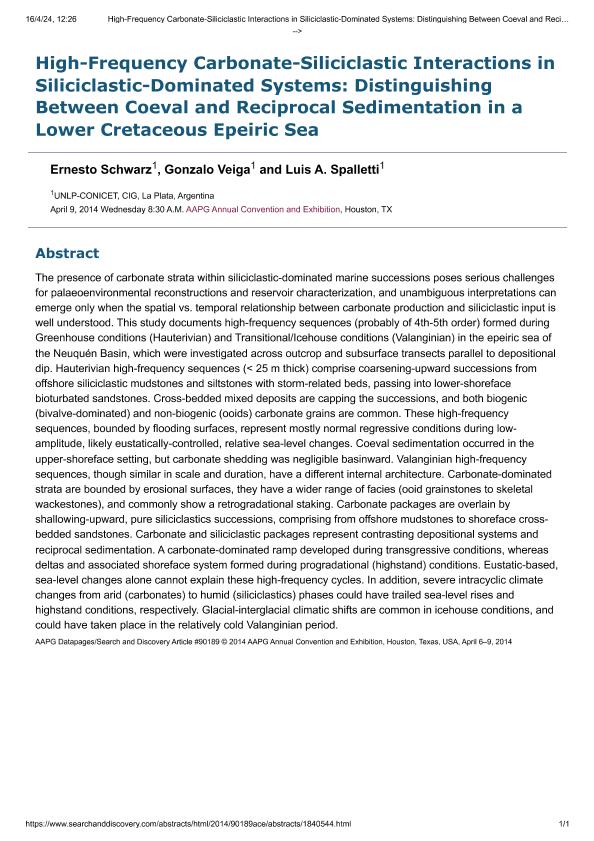Mostrar el registro sencillo del ítem
dc.contributor.author
Schwarz, Ernesto

dc.contributor.author
Veiga, Gonzalo Diego

dc.contributor.author
Spalletti, Luis Antonio

dc.date.available
2024-04-18T11:05:17Z
dc.date.issued
2014
dc.identifier.citation
High-frequency carbonate-siliciclastic interactions in siliciclastic-dominated systems: distinguishing between coeval and reciprocal sedimentation in a Lower Cretaceous epeiric sea; AAPG 2014 Annual Convention and Exhibition; Houston; Estados Unidos; 2014; 1-1
dc.identifier.uri
http://hdl.handle.net/11336/233381
dc.description.abstract
The presence of carbonate strata within siliciclastic-dominated marine successions poses serious challenges for palaeoenvironmental reconstructions and reservoir characterization, and unambiguous interpretations can emerge only when the spatial vs. temporal relationship between carbonate production and siliciclastic input is well understood. This study documents high-frequency sequences (probably of 4th-5th order) formed during Greenhouse conditions (Hauterivian) and Transitional/Icehouse conditions (Valanginian) in the epeiric sea of the Neuquén Basin, which were investigated across outcrop and subsurface transects parallel to depositional dip. Hauterivian high-frequency sequences (< 25 m thick) comprise coarsening-upward successions from offshore siliciclastic mudstones and siltstones with storm-related beds, passing into lower-shoreface bioturbated sandstones. Cross-bedded mixed deposits are capping the successions, and both biogenic (bivalvedominated) and non-biogenic (ooids) carbonate grains are common. These high-frequency sequences, bounded by flooding surfaces, represent mostly normal regressive conditions during low-amplitude, likely eustatically-controlled, relative sea-level changes. Coeval sedimentation occurred in the upper-shoreface setting, but carbonate shedding was negligible basinward. Valanginian high-frequency sequences, though similar in scale and duration, have a different internal architecture. Carbonate-dominated strata are bounded by erosional surfaces, they have a wider range of facies (ooid grainstones to skeletal wackestones), and commonly show a retrogradational staking. Carbonate packages are overlain by shallowing-upward, pure siliciclastics successions, comprising from offshore mudstones to shoreface cross-bedded sandstones. Carbonate and siliciclastic packages represent contrasting depositional systems and reciprocal sedimentation. A carbonate-dominated ramp developed during transgressive conditions, whereas deltas and associated shoreface system formed during progradational (highstand) conditions. Eustatic-based, sea-level changes alone cannot explain these highfrequency cycles. In addition, severe intracyclic climate changes from arid (carbonates) to humid (siliciclastics) phases could have trailed sea-level rises and highstand conditions, respectively. Glacialinterglacial climatic shifts are common in icehouse conditions, and could have taken place in the relatively cold Valanginian period.
dc.format
application/pdf
dc.language.iso
eng
dc.publisher
American Association of Petroleum Geologists

dc.rights
info:eu-repo/semantics/openAccess
dc.rights.uri
https://creativecommons.org/licenses/by-nc-sa/2.5/ar/
dc.subject
SEDIMENTOLOGIA
dc.subject
SISTEMAS MIXTOS
dc.subject
CUENCA NEUQUINA
dc.subject.classification
Geología

dc.subject.classification
Ciencias de la Tierra y relacionadas con el Medio Ambiente

dc.subject.classification
CIENCIAS NATURALES Y EXACTAS

dc.title
High-frequency carbonate-siliciclastic interactions in siliciclastic-dominated systems: distinguishing between coeval and reciprocal sedimentation in a Lower Cretaceous epeiric sea
dc.type
info:eu-repo/semantics/publishedVersion
dc.type
info:eu-repo/semantics/conferenceObject
dc.type
info:ar-repo/semantics/documento de conferencia
dc.date.updated
2024-04-11T21:00:54Z
dc.journal.pagination
1-1
dc.journal.pais
Estados Unidos

dc.journal.ciudad
Houston
dc.description.fil
Fil: Schwarz, Ernesto. Consejo Nacional de Investigaciones Científicas y Técnicas. Centro Científico Tecnológico Conicet - La Plata. Centro de Investigaciones Geológicas. Universidad Nacional de La Plata. Facultad de Ciencias Naturales y Museo. Centro de Investigaciones Geológicas; Argentina
dc.description.fil
Fil: Veiga, Gonzalo Diego. Consejo Nacional de Investigaciones Científicas y Técnicas. Centro Científico Tecnológico Conicet - La Plata. Centro de Investigaciones Geológicas. Universidad Nacional de La Plata. Facultad de Ciencias Naturales y Museo. Centro de Investigaciones Geológicas; Argentina
dc.description.fil
Fil: Spalletti, Luis Antonio. Consejo Nacional de Investigaciones Científicas y Técnicas. Centro Científico Tecnológico Conicet - La Plata. Centro de Investigaciones Geológicas. Universidad Nacional de La Plata. Facultad de Ciencias Naturales y Museo. Centro de Investigaciones Geológicas; Argentina
dc.relation.alternativeid
info:eu-repo/semantics/altIdentifier/url/https://www.searchanddiscovery.com/abstracts/html/2014/90189ace/
dc.conicet.rol
Autor

dc.conicet.rol
Autor

dc.conicet.rol
Autor

dc.coverage
Internacional
dc.type.subtype
Exposición
dc.description.nombreEvento
AAPG 2014 Annual Convention and Exhibition
dc.date.evento
2014-04-06
dc.description.ciudadEvento
Houston
dc.description.paisEvento
Estados Unidos

dc.type.publicacion
Journal
dc.description.institucionOrganizadora
American Association of Petroleum Geologists
dc.description.institucionOrganizadora
Society for Sedimentary Geology
dc.source.revista
AAPG Annual Convention and Exhibition: Abstracts
dc.date.eventoHasta
2014-04-09
dc.type
Exposición
Archivos asociados
